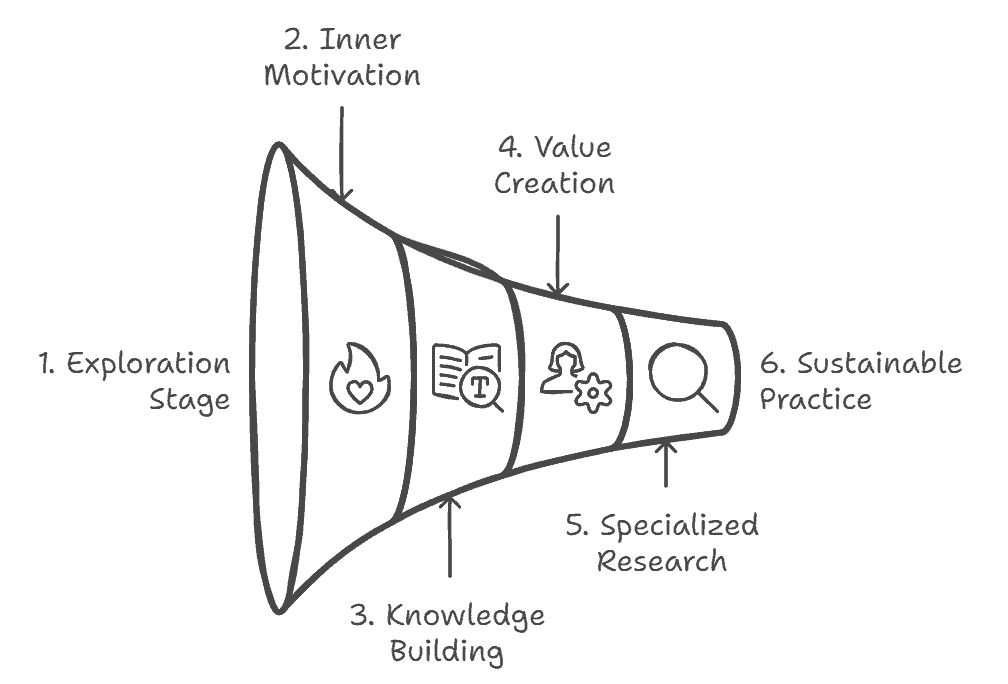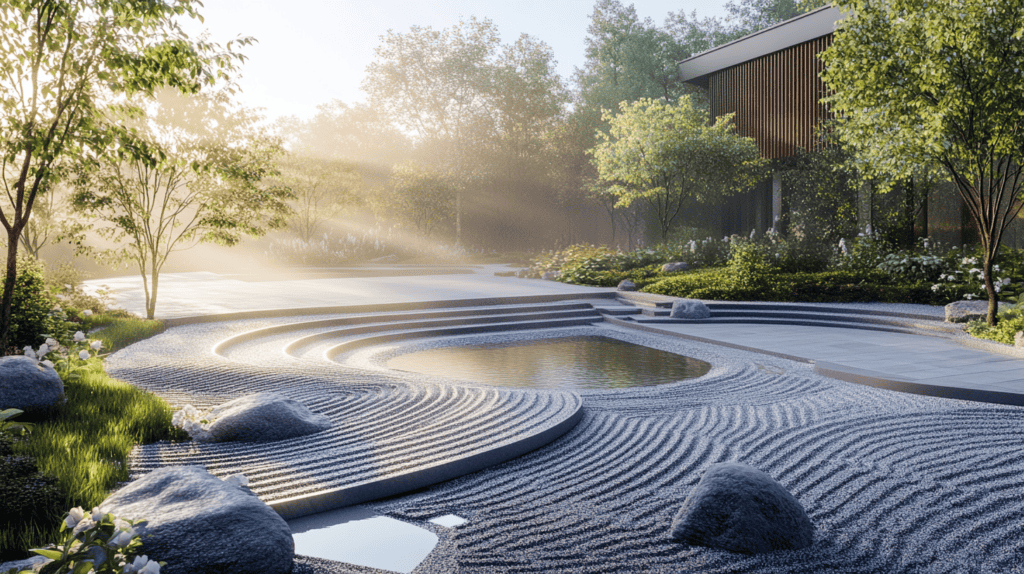The Learning Journey: A New Model for Understanding Knowledge Acquisition
Learning isn’t just about moving from beginner to expert. It’s a complex journey that changes its nature as we progress. While traditional model like Dreyfus model efficiently describe competency levels, they don’t capture the shifting purposes and goals of our learning journey.
Think about how differently you approach learning when you’re first exploring a new field versus when you’re trying to produce results. Or how your focus changes when you’re building foundational knowledge compared to when you’re researching specific questions. These aren’t just different skill levels – they’re fundamentally different modes of learning with distinct purposes.
This article introduces a six-stage model that maps these changing purposes of learning:
- Open exploration
- Inner motivation: Finding your interest
- Building solid knowledge-skill
- Creating values
- Researching specific questions
- Developing integrated know-how for sustainable practice

Understanding these stages helps answer crucial questions: Why am I learning this? What should I focus on right now? How do I move forward? Whether you’re changing careers, developing new skills, or deepening existing expertise, recognizing your current stage can transform how you approach learning.
Let’s explore each stage and discover how they build upon each other to create a complete learning journey.
1. The Exploration Stage: Mapping Your Territory
The exploration stage mirrors early expedition voyages – like Columbus discovering new continents or modern space missions venturing into the unknown. This phase particularly resonates with teenagers and young adults, who see the world as an endless canvas of possibilities. Everything seems interesting, every path holds potential, and the sheer volume of options and new information can feel both exciting and overwhelming.
Like these young minds, exploratory learning embraces the vastness of possibility. You’re not searching for specific answers but rather discovering what exists. Think of how teenagers absorb new interests almost weekly – music, sports, technology, art – each representing a potential path forward. This natural tendency to explore widely before focusing deeply is not just normal; it’s essential for genuine learning and self-discovery.
The exploration phase works through statistical opportunity – the more territory you cover, the more likely you are to discover something valuable. This mirrors how young people often find their passions through random encounters: a chance introduction to programming, an inspiring art class, or a fascinating science experiment. Not every exploration leads to lasting interest, but each contributes to mapping your personal territory of possibilities.

The “shiny object syndrome” – being constantly drawn to new and exciting possibilities – is actually natural and even beneficial during this phase. It drives broad exploration and helps you discover what truly resonates with your interests. The exploration phase sets the foundation for all future learning by creating your personal map of possibilities and potential paths forward. Like early explorers, you’re not just learning about the territory – you’re learning about yourself and what captures your imagination.
Like a ship first venturing into open waters, this stage faces endless possibilities with few navigational aids. The horizon stretches in all directions, full of potential discoveries, but also uncertainty about which course to set.
Practical Applications
- Keep a discovery journal documenting interesting encounters
- Follow diverse paths without early judgment
- Notice what naturally draws your attention
- Create mind maps connecting different interests
2. Finding Inner Motivation: The Spark That Drives Learning
Finding genuine inner motivation transforms random exploration into purposeful learning. This stage is about discovering what naturally resonates with you – where interest isn’t forced but flows naturally.
During exploration, you encounter countless possibilities. But certain areas catch your attention differently – they create a spark of genuine curiosity. This isn’t about what others think you should learn or what seems profitable. It’s about recognizing what makes you want to dig deeper naturally.

Young people often feel pressure to choose practical paths over personal interests. However, sustainable learning requires internal drive. Without it, even the most promising career path can lead to burnout and disengagement. The key is recognizing authentic interest – when you find yourself thinking about a topic outside of required times, when you’re excited to learn more, when challenges feel engaging rather than draining.
This stage requires honesty with yourself. What truly interests you versus what you think should interest you? What topics energize rather than exhaust you? Which subjects do you naturally gravitate toward?
Success in this phase means identifying areas where your curiosity is genuine and sustainable. You’ll know you’ve found it when learning feels less like work and more like exploration you want to pursue.
Like a ship finding favorable winds, discovering your inner motivation provides natural momentum for your learning journey. Instead of fighting against the current, you’re propelled forward by genuine interest.
Practical Applications
- Track when you lose track of time while learning
- Notice which topics energize versus drain you
- Distinguish between external pressure and genuine interest
- Pay attention to interests that persist over years despite neglect – these signal genuine inner drive
- Test if interest persists beyond initial excitement
3. Building Knowledge-Skill: The Investment Phase
This stage marks the transition from interest to expertise. Having found what genuinely motivates you, you now invest time and energy to build practical, usable knowledge.
Unlike theoretical learning, this phase focuses on developing applicable skills. You’re not just gathering information – you’re building competence that can be put to work. This is where formal education, training, or self-study programs can provide valuable structure.
The investment nature of this phase is crucial. You’re not yet focusing on producing results or generating value. Instead, you’re accumulating expertise, understanding fundamentals, and developing practical capabilities. Like building a foundation, this work might not be immediately visible but determines what you can construct later.

Success requires sustained effort without immediate return. However, your inner motivation from the previous stage makes this investment sustainable. You’ll notice your knowledge becoming more structured and your understanding deeper. Ideas connect naturally, and you begin seeing patterns others might miss.
Like a ship steadily crossing vast distances powered by constant winds, this stage is about consistent progress through sustained effort. While you might produce some output as practice, the focus remains on building capability rather than generating results.
Practical Applications
- Create learning milestones for steady progress
- Balance theoretical knowledge with practical application
- Find mentors who’ve walked similar paths
- Build fundamentals before advanced concepts
- Monitor motivation levels
- Use Dreyfus model to track progress at skill building
- Maintain connection to your inner drive
4. Creating Results: From Knowledge to Value
In this stage, your accumulated knowledge begins transforming into tangible output. The focus shifts from learning to producing valuable results that others can recognize and use. Your previously built knowledge-skill base now serves as a toolkit for creating specific solutions and products.

The nature of learning changes. Instead of structured study, you learn through the challenge of creating real output. Each project or deliverable pushes your capabilities further while providing concrete value. The satisfaction comes not just from knowing, but from seeing your knowledge manifest in tangible results.
Success metrics shift from understanding to achievement. Your output might be creative works, solutions to problems, or innovations in your field. The key is that your knowledge now generates recognized value.
Like a ship now carrying valuable cargo across established routes, this stage transforms accumulated knowledge into productive output. Your expertise becomes a tool for creating value rather than just a collection of capabilities.
[Note: Each stage builds naturally on previous ones – you can’t sustainably produce results without the knowledge foundation built earlier.]
Practical Applications
- Start with small, achievable projects
- Use feedback to improve output quality
- Document successes and lessons learned
- Build a portfolio of completed work
- Never stop learning while producing – adopt Kaizen mindset and After Action Review technique
- Avoid routine execution – seek continuous improvement
5. Researching Specific Questions: Pioneering New Territory
At this stage, you begin pushing the boundaries of your field through focused investigation. Having mastered the fundamentals and created valuable output, you now tackle specific, challenging questions that others haven’t solved.
This is where expertise deepens into specialized knowledge. Rather than broad learning, you investigate precise problems, often in unexplored territory. Like academic researchers seeking gaps in current knowledge, you identify areas where existing solutions fall short.

Success here means finding answers to questions that expand the field’s boundaries. Your investigations might reveal new approaches, challenge accepted wisdom, or solve previously intractable problems. The focus shifts from applying known solutions to creating new ones.
The research phase requires careful methodology – defining specific questions, testing hypotheses, and documenting findings. This targeted exploration differs fundamentally from the broad discovery of the first stage. Your existing knowledge base helps you recognize truly significant questions and potential breakthroughs.
Like a ship mastering specific, challenging routes that few others navigate, this stage develops unique expertise through focused investigation of specific problems. Over time, successfully resolving a number of such specialized challenges creates a synergistic body of knowledge – a unique expertise that sets you apart in your field.
Practical Applications
- Identify gaps in current solutions
- Keep detailed records of investigations
- Connect with others exploring similar questions
- Build on previous successes systematically
- Look for unsolved problems in real life situations
- Convert personal challenges into research opportunities
6. Developing Holistic Know-How: Creating Sustainable Practice
This final stage focuses on integrating all previous phases into a sustainable, harmonious workflow. Beyond just solving problems or creating output, you’re now optimizing how you work and maintain your expertise.
Rather than pushing for more output or deeper specialization, you focus on finding balance and efficiency. How can you maintain high performance while avoiding burnout? How do you keep learning while consistently delivering value?
The goal shifts from advancement to sustainability and wisdom. You develop workflows that maintain quality while preserving energy. Your expertise becomes not just what you know, but how you apply it effectively over time.

Like a ship that has established profitable routes and lasting commercial relationships for generations, while maintaining its capability, this stage transforms individual successes into a sustainable, long-term practice.
[Note: This stage isn’t about settling, but about creating systems that support continued growth and value creation while maintaining personal equilibrium.]
Practical Applications
- Create sustainable routines and workflows
- Balance productivity with personal wellbeing
- Develop systems for continuous improvement
- Share knowledge while continuing to learn
- Maintain balance to prevent burnout
- Recognize sustainable pace is key to longevity
How LJF Complements the Dreyfus Model
While the Dreyfus model maps competency levels (Novice to Expert), the Learning Journey Framework (LJF) examines learning purposes and focus. These models complement each other, offering different perspectives on the learning path.
The Dreyfus model describes how people perform at each skill level:
- Novices follow rigid rules
- Advanced beginners recognize situational elements
- Competent performers plan consciously
- Proficient performers see holistically
- Experts work intuitively
LJF, meanwhile, focuses on the purpose of learning at each stage:
- Exploration: Discovering possibilities
- Inner Motivation: Finding sustainable drive
- Knowledge-Skill: Building practical capability
- Results: Creating value
- Specialization: Developing unique expertise
- Know-How: Sustaining practice
These models intersect naturally. Early LJF stages often align with novice/advanced beginner Dreyfus levels, while later LJF stages typically require proficient/expert level competence. However, you might cycle through LJF stages multiple times as you advance through Dreyfus levels in different aspects of your field.
Together, these frameworks provide a more complete picture – Dreyfus showing how competency develops, LJF revealing how learning purposes evolve.
The Learning Journey Continues
The Learning Journey Framework (LJF) maps the evolution of learning purpose and focus through six distinct stages, each building on previous foundations. Understanding your current stage helps optimize your learning approach and set realistic expectations.
A critical insight from the framework is the importance of not skipping stages. You cannot effectively:
- Create valuable output without first building solid knowledge
- Develop specialized expertise without broad foundational understanding
- Establish sustainable practices without experience in creation and research
Like building a house, each stage provides essential foundation for the next. Attempting to skip stages often leads to unstable progress and eventual setbacks.
While progress generally flows from exploration to expertise, learning isn’t strictly linear. You may revisit earlier stages as you expand into new areas or deepen existing knowledge. The key is matching your learning approach to your current stage while maintaining connection to your inner motivation.
The journey of learning never truly ends – it evolves. Use this framework as a map to guide your path, understand your progress, and optimize your growth at each stage.